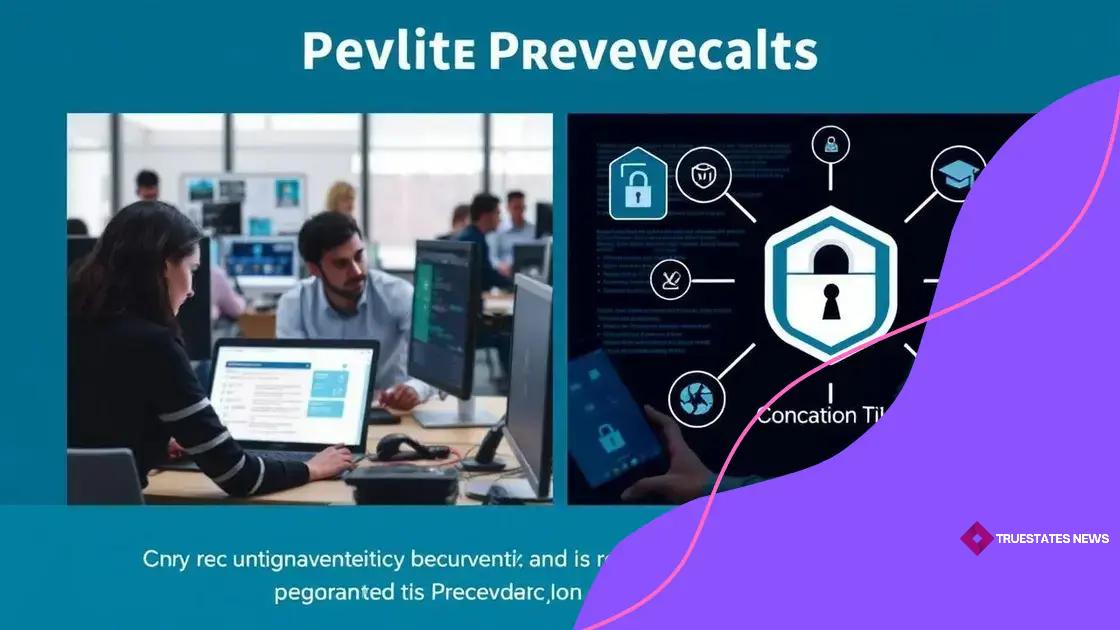Cybersecurity threats addressed by agencies: what to know

Cybersecurity threats addressed by agencies include malware, phishing, and DDoS attacks, with agencies employing incident response, threat intelligence, and collaborative strategies to protect data and systems effectively.
Cybersecurity threats addressed by agencies are on the rise as digital landscapes evolve. Have you ever considered how these threats can impact your everyday online activity? In this article, we delve into how agencies are tackling these challenges and what strategies they employ to keep us safe.
Understanding common cybersecurity threats
Understanding common cybersecurity threats is crucial for anyone who uses the internet. With technology advancing, these threats have become more sophisticated. Recognizing them helps you protect your personal and professional data.
Types of Cybersecurity Threats
There are several main types of cybersecurity threats to be aware of. Knowing what they are can aid in prevention.
- Malware: This type includes viruses, trojans, and spyware designed to harm your system.
- Phishing: Attackers trick you into providing sensitive information through fake emails and websites.
- Man-in-the-Middle Attacks: These occur when attackers intercept communication between two parties.
- DDoS Attacks: Attackers overwhelm a system with traffic, causing disruptions.
Understanding these threats means you can take steps to avoid falling victim. For instance, you might notice phishing attempts in your emails often disguised as legitimate correspondences. It’s essential to always check the sender’s address and avoid clicking on suspicious links.
Cybersecurity Threats in Everyday Life
It’s important to realize that cybersecurity threats can hit anyone. Everyday activities, such as online banking or shopping, expose you to risks. Implementing security measures can drastically reduce your vulnerability.
For example, using strong, unique passwords is a basic but effective strategy. Enable two-factor authentication wherever possible to add an extra layer of security.
As you learn about common cybersecurity threats, remember that staying informed is your best defense. Regularly updating your software and engaging in safe browsing habits are ways to shield yourself. The digital landscape is ever-evolving, and being proactive can make a significant difference in keeping your information secure.
Role of agencies in cybersecurity
The role of agencies in cybersecurity is vital for maintaining safe digital environments. These agencies are responsible for monitoring, protecting, and responding to security threats that affect both individuals and organizations.
Functions of Cybersecurity Agencies
Agencies perform a variety of functions to counteract cyber threats. They are not only reactive but also proactive in their approaches.
- Incident Response: Agencies coordinate swift responses to cyber incidents, helping affected parties recover and prevent future attacks.
- Threat Intelligence: They gather and analyze data about emerging threats, providing critical information to organizations and governments.
- Public Awareness Campaigns: Through education and training, agencies inform the public about best practices for online safety.
- Policy Development: Agencies help formulate policies aimed at enhancing cybersecurity measures across various sectors.
By understanding their roles, individuals can better appreciate how cybersecurity agencies work behind the scenes. For example, when a new ransomware threat emerges, these agencies swiftly disseminate information to help organizations defend against attacks.
Collaboration Across Sectors
The role of agencies in cybersecurity also involves collaboration with private sectors and other governments. Cyber threats do not recognize borders, so international cooperation is essential. Agencies often share information that can lead to quicker responses to threats affecting multiple countries.
This collaborative spirit fosters innovation and ensures that strategies remain effective amid rapidly changing attack vectors. Engaging in partnerships allows agencies to develop comprehensive defenses and share resources. This is especially important as cybercriminals are continuously evolving their tactics.
Preventive measures implemented by agencies

Preventive measures implemented by agencies are essential for reducing the risk of cyber threats. These strategies are designed to stop attacks before they happen rather than just responding to them.
Key Preventive Measures
Agencies use a variety of techniques to enhance cybersecurity. Here are a few of the principal measures:
- Regular Security Audits: Agencies conduct thorough reviews of systems to identify and fix vulnerabilities.
- Employee Training: Training staff on security practices is vital, as many attacks target human error.
- Encryption: Encrypting sensitive data protects it even if it falls into the wrong hands.
- Firewalls and Intrusion Detection Systems: These systems act as barriers against unauthorized access and alert agencies to potential threats.
By incorporating these measures, agencies create a robust defense against various threats. For instance, regular audits ensure that any weaknesses are addressed quickly, preventing potential breaches before they occur.
Collaboration and Information Sharing
An important aspect of the preventive measures is the collaboration among agencies and private organizations. By sharing data about threats, they improve their collective security. This collaboration allows for quicker identification of new threats and development of response strategies.
Moreover, the use of shared platforms and tools facilitates real-time communication, which is critical during potential incidents. Increasing awareness of current threats and known vulnerabilities strengthens defenses across all sectors. Through these efforts, agencies aim to create a safer digital environment for everyone, highlighting the importance of knowing that cybersecurity is a shared responsibility.
Case studies of successful interventions
Case studies of successful interventions in cybersecurity provide valuable insights into how agencies can effectively combat threats. By examining real-world examples, we can see what strategies worked and why they matter.
Notable Cybersecurity Interventions
Several cases highlight the proactive measures taken by agencies to thwart significant cyber threats. Understanding these interventions helps in recognizing best practices.
- Operation Phish Fry: This initiative targeted a major phishing operation, successfully taking down multiple networks that engaged in fraud.
- WannaCry Ransomware: Agencies collaborated internationally to halt the spread of this ransomware through quick identification and patching of vulnerabilities.
- The SolarWinds Hack: Agencies worked together to respond to this supply chain attack, sharing intelligence that strengthened defenses across the affected sectors.
- Equifax Data Breach: Experts analyzed the breach and created new policies to prevent similar incidents, focusing on improving security protocols.
These examples underscore the importance of swift action and collaboration among agencies. For instance, in the case of WannaCry, timely response and patching not only prevented further damage but also highlighted the need for continuous monitoring of systems.
Lessons Learned from Interventions
Each successful intervention teaches us crucial lessons about preparedness and response. Continuous training and updates to cybersecurity measures are vital in today’s rapidly changing digital landscape. Organizations can learn from these case studies, adopting similar strategies to safeguard their information.
Investing in technology and employee training is essential for maintaining robust defense systems. Agencies illustrate that by remaining vigilant and adaptive, they can mitigate potential threats effectively. Real-world cases remind us that cybersecurity is a dynamic field requiring ongoing commitment and improvement.
Future trends in cybersecurity strategies
Future trends in cybersecurity strategies are shaping how agencies will respond to threats in an increasingly digital world. As technology evolves, so do the tactics of cybercriminals, making it essential for defensive measures to innovate.
Emerging Technologies
Agencies are looking toward new technologies to enhance cybersecurity. Here are some key areas of focus:
- Artificial Intelligence: AI is being used to predict and identify vulnerabilities faster than traditional methods.
- Machine Learning: This helps in recognizing patterns of behavior, allowing for quicker responses to potential incidents.
- Blockchain Technology: Blockchain offers secure ways to handle transactions and data, reducing risks of data breaches.
- Zero Trust Security: This strategy requires strict identity verification for every user and device, whether inside or outside the network.
Investing in these technologies allows agencies to stay one step ahead of cybercriminals. For example, using AI and machine learning can automate threat detection, reducing the time taken to respond to incidents.
Collaboration and Information Sharing
Future trends also emphasize the importance of collaboration among different agencies and organizations. By sharing information about emerging threats, they can create a more unified defense. This fosters a culture of mutual support and collaboration in cybersecurity.
Additionally, public-private partnerships will likely become more prominent, enabling both sectors to leverage each other’s resources and expertise. As threats continue to evolve, a cooperative approach will be vital in safeguarding data.
Staying adaptive and responsive will be key to future strategies. Agencies must embrace new technologies while enhancing their collaboration efforts to effectively navigate the complex cybersecurity landscape.
FAQ – Frequently Asked Questions about Cybersecurity Threats and Agency Responses
What are common cybersecurity threats agencies address?
Agencies tackle threats like malware, phishing, DDoS attacks, and man-in-the-middle attacks to protect data and systems.
How do agencies respond to cyber incidents?
Agencies coordinate swift responses through incident management, public awareness campaigns, and threat intelligence sharing.
Why is collaboration important in cybersecurity?
Collaboration among agencies and private sectors enhances information sharing, leading to quicker identification and prevention of threats.
What future trends are shaping cybersecurity strategies?
Future trends include the use of AI and machine learning for threat detection, as well as a focus on zero trust security models.
